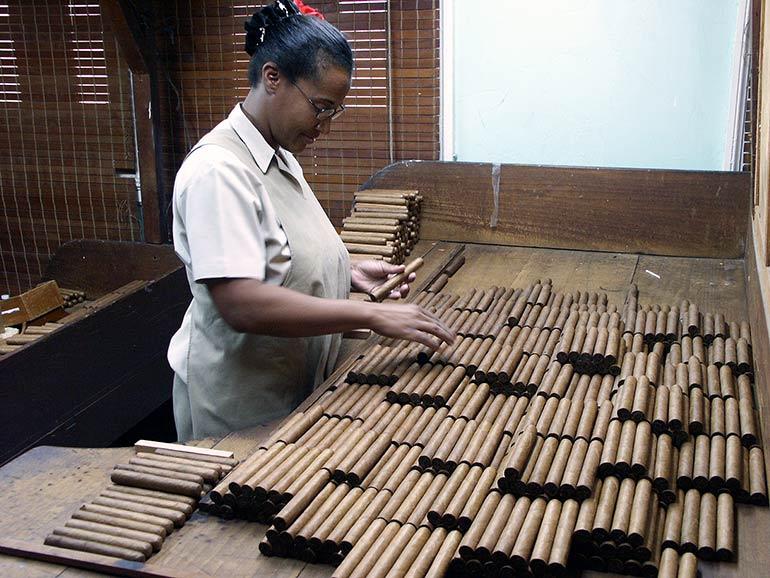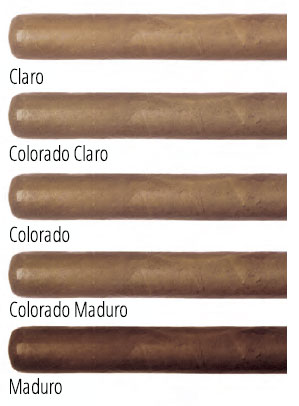Search the Community
Showing results for tags 'wrapper'.
-
I came across the following article of interest from Simon Chase, the great British 'Cigar Sage' who worked for Hunters and Frankau from 1977 until his retirement in 2009. As I've stated before, I always find what he has to say of interest, due to his passion and experience for Habanos cigars. His latest article for Cigar Journal discusses the the effect that wrappers have on the taste of a cigar Wrappers: More Than Just a Shell October 27, 2018 Simon Chase Few topics in cigar lore attract a greater disparity of views than the effect that wrappers have on the taste of a cigar. Some people are so influenced by the colour that they are convinced that light- brown wrappers promise light-tasting smokes and, conversely, that dark wrappers threaten overpowering flavours. Others insist that wrappers have no effect whatsoever on the taste. After all, a wrapper is only half of a single leaf, often wafer thin because it comes from a shadegrown plant. How could its influence be significant when compared to the cluster of three or four different types of sturdy, sun-grown filler leaves blended uniquely to fulfil the goals for the specific tastes sought by different brands. Forty years ago when I joined the Havana trade, my schooling was clear. Wrappers were for appearance, not taste. Imagine my surprise when, a dozen or so years later at the start of the cigar boom in the US, I heard a leading Dominican Republic manufacturer state in public that wrappers could account for no less than 70 percent of the ultimate taste of his products. I was tempted to suggest that if his wrappers could prove so dominant, then his fillers must be rather insipid, but I didn’t because I believed that there was a sounder explanation for the role of the wrapper. Wrappers come in a wide variety of colours, caused principally by where they are grown on the tobacco plant. The leaves at the bottom of the plant, which are the oldest and thinnest, will, after curing and fermentation, produce the lightest colours; whereas the younger, thicker leaves from the top of the plant will result in much darker colours. Throughout the production process, agricultural and industrial, a huge amount of effort goes into ensuring that the final array of cigars in any box, bundle or pack are perfectly colour matched. Ultimately the range of tones will fall into one of five colour descriptions: Claro: very light brown; Colorado Claro: light brown; Colorado: brown; Colorado Maduro: dark brown; and Maduro: very dark brown/ almost black. It follows that Claro wrappers will come from the bottom leaves of a plant, Maduro wrappers from the leaves at the top, and the other classifications from the levels in between. Image by courtesy of Hunters & Frankau | Int the foreground, the wrapper colours appeal to me; Claro for light flavoured blends like Hoyo de Monterrey, and Colorado or Colorado Maduro for full flavoured blends like Partagas to Hunters in England for Ramon Allones. There is another factor that varies along the same lines, namely the sugar content in the leaves. There is more sugar in the Maduro leaves from the top of the plant, and much less in the Claro leaves from the bottom. As a result, you find that very dark Maduro leaves bring sweetness to a cigar’s taste that is apparent even when you first place it unlit between your lips. Conversely, light-coloured wrapper leaves add dryness to the cigar’s taste. My contention is that wrappers do make a significant contribution to the taste of a cigar, but not with regard to its fullness or lightness of flavour. Instead they add what I describe as a ‘top taste’, based on an axis from dry to sweet, subject to their colour. As a personal preference, I find the sweetness of darker wrappers goes best with rich, earthy, full flavoured filler blends, whereas there is a natural compatibility between the dryness of pale-brown wrappers with more delicate confections. As a result, taking Cuba’s two most popular Robustos as examples, I would always choose a Partagás Serie D No. 4 with a Colorado or Colorado Maduro wrapper, and a Hoyo de Monterrey Epicure No. 2 wrapped in a Claro leaf. Let me make it clear that this is not a rule; it is merely my personal taste. There are many respected aficionados who order their Epicure No. 2s with dark wrappers or their D 4s with light ones. It is up to you to decide what suits your palate. Over the years, the market’s preferences have changed. When I started out, Claro wrappers were all the rage. Up until the 1970s, some Cuban factories marked boxes with the colour of their contents, either with the full names – Claro, Colorado Claro, and so on. Or sometimes with a code – CCC for Claro, CC for Colorado Claro and C for Colorado. They noted the colours on their invoices, too, as can be seen on the example from Partagás in 1939 to Hunters for Ramón Allones (see page XX). Most of the cigars are Claro (CCC), even for a full-flavoured brand. Today the variety of colours available from Cuba is much wider, particularly when you include such specialities as the Limited Edition lines. So I, for one, would welcome the return of marking the wrapper colours on boxes. Source: https://www.cigarjournal.com/wrappers-more-than-just-a-shell/
-
Hello everyone, first post, so new to FOH. Name is Barry and glad to be a part of what goes on here. Read a previous post on this but there were not too many responses. I have noticed that many of my cigars wrappers tend to get lighter with age. This seems to be most prominent with my montes. 2's 4's and petit 2's. Masters seem to hold there own. Keep at 65/65. Is this a common phenomenon? All boxes have 2 to 3yrs on them. Thanks much
-
I've wanted to build a reference thread in regards to the difference between maduro shade wrappers and the maduro wrapper process for a little while now, as I believe the terms can be a little confusing for the average cigar smoker. The main difference between these terms is in understanding that one of these is a reference to the colour or shade of the wrapper, the other represents the process undertaken to develop a wrapper for specific brands such as the Cohiba Maduro 5 series and the Partagas Maduro No.1. Wrappers come from shade-grown plants, with the lightest shades coming from the bottom of the plant and the darkest shades coming for the top of the plant as it gets the most sun. In order these are; Claro, Colorado Claro, Colorado, Colorado Maduro and Maduro. These distinctions describe the shading of the wrappers Maduro wrappers utilised in the Cohiba Maduro 5 series (released in 2007) come for the very top of these shade-grown plants, with extra aging (5 years) and fermentation required. These result in an added 'sweetness' 'to the flavour of the blend. The Partagas Maduro No.1 was released in 2015. Habanos S.A described this cigar as follows, 'The Partagas Maduro No.1 offers the smoker all the flavour and intensity of Partagas, with a very special wrapper, selected from the best leaves harvested from the top levels of the “ Shade-Grown ” tobacco plant and which has developed, after an additional period of fermentation, a texture and intense color that are the ideal complements to the full flavour blend of Maduro No.1'. And so, maduro wrappers in this sense differ from the shading reference above due to the process undertaken to produce these wrappers, which require extra aging and fermentation. What about Limited Edition cigars? Do these utilise maduro-shaded wrappers or technically-speaking, are they maduro-processed wrappers? The wrappers on the cigars are described thusly, 'Limited Edition wrappers are darker than those found on standard Habanos. Darker wrappers come from the leaves picked from the higher levels on shade-grown tobacco plants, which are thicker. Such leaves demand longer periods for fermentation and ageing so they are left in bales for at least two years before the cigars are made.' In my opinion, these are maduro-shaded wrappers that are a little sweeter than normal, helping to influence the common 'chocolate-y' flavour of Limited Edition cigars. (N.B. Information from this thread has been sourced from Habanos.com)
- 29 replies
-
- 11
-

-

-

Interesting Cigar Failure Modes
PapaDisco posted a topic in Cigars Discussion Forum "the water hole"
Just this week I had two interesting wrapper failures in PSD4 cigars, both from the same "three-pack-tube" box, but probably not originally so (explained below). Just as I was finishing the first third, the wrapper in the middle of the cigar started to flake off. It wasn't the whole wrapper, it just looked like a tissue thin layer of the wrapper, sort of like flaky pastry dough. The cigar maintained its integrity in both cases and easily smoked to the nub. One got pretty strong and harsh at the very end, the other did not. It was kind of ironic because that same night at the club I took note of a couple of other members smoking non-CC's with wrappers that were disintegrating in rather flamboyant style. Perhaps this was Karma coming back to bite me for my schadenfreude? Or perhaps my double fail was a result of previous over drying. The stock of PSD4's I've (up until now) acquired on my way through the Hong Kong airport at the Duty Free shop there. They have wonderful (looking) walk-in humidors (and they also charge you out the yin-yang! ). However they do have a nice selection and it's a tempting stop for those of us living in CC impoverished regions. I only recently learned that their walk-in "Humidor" actually has no humidification at all! And the warehouse down below has neither humidification nor temperature control! Of the PSD4's I'd bought there, I've always had to sort through the tubed-3-packs because the stock was in such poor condition: dried out, busted wrappers, splits, etc. It would take three boxes to make one good box. Funny that the other cigars I bought there (Cohiba robustos, SVI's, Monte 4's by the 25, Punch Punch in tubes) were never so roughed up. Mostly it was just the PSD4's. I'd bring the cigars home, packed in a baggie with a damp paper towel for the flight, and let them sit in my Humi for a couple of months before attempting to smoke. Early on I busted a couple of wrappers by keeping the Humi too damp and also uncapping the tubes. I switched to a lower Humidity (69% Boveda's) and leave the cigars capped and boxed now (to slow down the humidity exchange) and everything since has worked fine (and things seem to smoke better below 70Rh than above IMHO). Anyway, I'm guessing that these two PSD4's were just terminally damaged from the start. Even though they had been gently brought back to proper humidity over 3-4 months, and even though there was no evident damage to the wrapper on lighting, they were likely an example of a dried out cigar that couldn't be saved. The only odd thing was the way the wrapper flaked off in that super-thin way. Could the problem perhaps have been a funky leaf at assembly? Both cigars smoked fine, but were not the best tasting PSD4's ever. What's the strangest cigar fail you guys have ever seen?

.png.15b5f6bc4159a73805a9f118f79a68ca.png)




